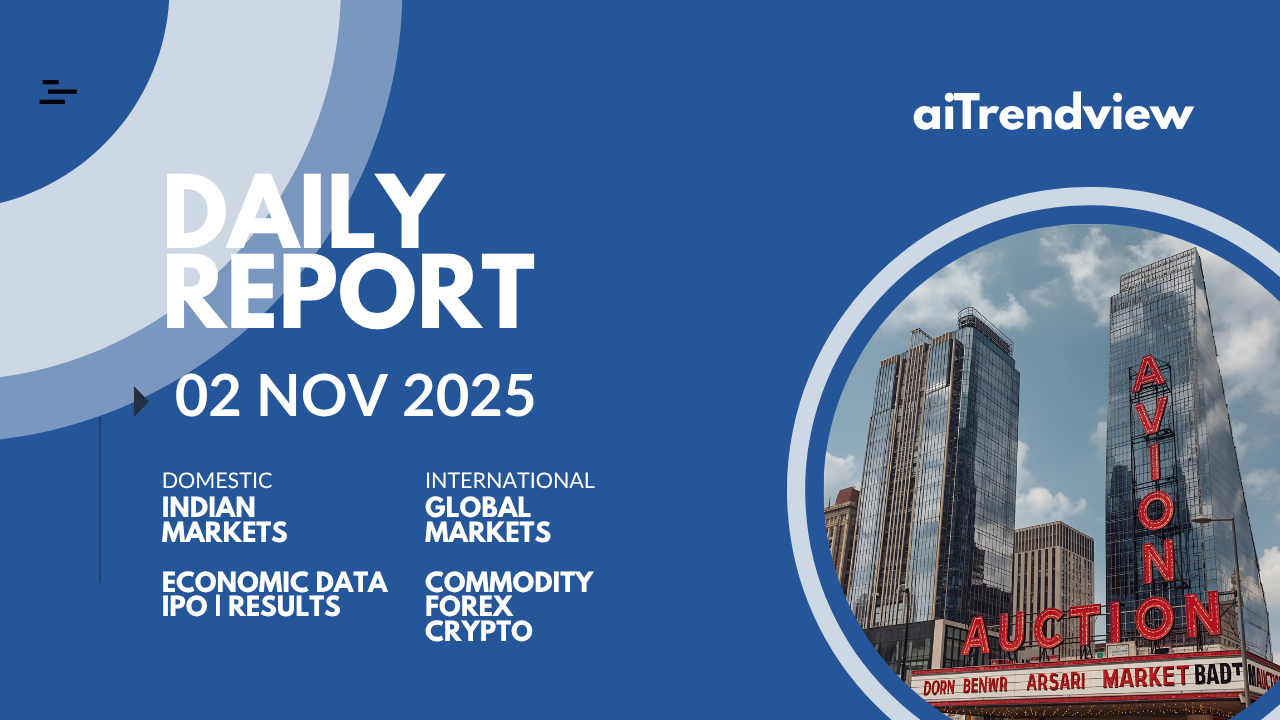

Comprehensive Global Market Outlook for November, 2025
Global Market Overview
Global equity markets closed October near recent highs, supported by the U.S. Federal Reserve’s 25-basis-point rate cut to a 3.75–4.00% range and a partial easing of U.S.-China trade tensions with tariff rollbacks agreed by the leaders. Despite this, Fed Chair Powell cautioned that further rate cuts are not assured, curbing late-month advances. Asian bourses outperformed with South Korea up 19.3% and Japan 14.8% month-to-date, while U.S. indices including Nasdaq and S&P 500 and European markets like FTSE and CAC gained roughly 4%. Volatility remained subdued; the VIX held steady around 16.5 to 17 levels. Investor sentiment is mixed, with fear prevailing on sentiment gauges, though speculative flows into digital assets remain robust.
Technology stocks led gains, propelled by enthusiasm around AI, highlighted by Nvidia’s market capitalization briefly reaching $5 trillion. Value and cyclical sectors also benefited from easing bond yields. The U.S. 10-year Treasury yield stabilized near 4.10%, with a mildly steepening yield curve (10-year minus 2-year spread about 0.5%). The U.S. dollar strengthened, hitting a 3-month high near 99.7 on the DXY index, driven by Fed caution and a hawkish Bank of Japan keeping policy rates at 0.50%. The Japanese yen weakened sharply to around ¥154 per USD while the euro slipped to about 1.155 against the dollar amid diverging monetary policy paths.
Regional Overview
U.S. indices are near all-time highs with the S&P 500 around 6,800 and Nasdaq exceeding 25,000, supported by strong corporate earnings and technology sector momentum. European equities remain healthy, with the STOXX 600 supported by strength in UK and Eurozone markets. In Asia, China’s market lagged due to a weakening economy with the manufacturing PMI falling to 49.0, signalling contraction, while India maintained expansionary momentum with a PMI near 57.7. Emerging markets showed a mixed picture; Brazil delivered modest gains year-to-date, but Turkey’s market remains pressured by persistently high inflation around 33% and contracting manufacturing PMIs.
Corporate Earnings and Sector Highlights
Big technology companies broadly beat earnings expectations. Apple reported Q4 revenue of $102.5 billion (+8% YoY) driven by record iPhone and services sales. Amazon’s revenue rose 13% to $180.2 billion with AWS growing 20%. Alphabet surpassed $100 billion in revenue for the first time with a 16% increase to $102.3 billion and Google Cloud revenue climbed 34%. Microsoft posted a 13% rise in Q3 revenues to $70.1 billion, fuelled by cloud and AI demand. Meta’s revenue grew 26% to $51.2 billion despite a one-off $15.9 billion tax expense impacting net income. The semiconductor sector, led by Nvidia, surged with the latter reaching a $5 trillion valuation. Energy companies like ExxonMobil saw profits rise to $7.55 billion; however, oil refiners faced margin pressures amid surplus supply.
Scheduled corporate earnings for the week of November 3 include IDEXX Labs, Publicis, Ryanair, BioNTech, ON Semiconductor, and more, with many firms expected to continue reporting solid quarterly results that will influence near-term market sentiment.
Technical Market Assessment
Technical indicators remain bullish for major U.S. indices. The S&P 500 holds well above its 50- and 200-day moving averages, having decisively broken above 6,800 resistance. The Nasdaq 100’s breakout above 25,000 and its long-term uptrend channel signals accelerating momentum toward 27,000. Mildly overbought RSI levels suggest caution, yet pullbacks to prior breakout levels of 6,750 on the S&P and 25,000 on the Nasdaq are viewed as buy zones. Asian markets like the Nikkei and Kospi maintain strong positions above key moving averages.
Fixed Income, Forex, and Commodities
Oil prices stabilized in late October, with Brent crude between $65 and $70 per barrel and WTI around $62–68. Despite record OPEC+ output (+2.7 million bpd since April), oil markets face subdued demand. OPEC+ signals a small output increase (+137,000 bpd) for December amid geopolitical factors such as U.S. sanctions on Russian oil and a tentative Gaza ceasefire, which has lowered Middle East risk premiums temporarily.
Gold remains near record highs (~$4,000/oz), up about 54% year-to-date, despite a modest dip following Fed hawkish remarks. Analysts expect consolidation with Morgan Stanley forecasting an average $4,300 per ounce in H1 2026. Industrial metals like copper remain flat, influenced by China’s economic softness.
Currency markets see the U.S. dollar strong on Fed caution, with the DXY index at a multi-month high around 99–100. The euro trades near €0.86 (~$1.155). The yen remains weak near ¥154 to the dollar following the BoJ’s cautious stance on policy rates. Commodity-linked currencies have gained modestly, while emerging market currencies remain volatile, exemplified by the Turkish lira under inflationary pressure and the Chinese yuan weak near 7.2/USD.
Treasury yields retraced part of their earlier declines but remain below May highs. The U.S. 10-year yield stands near 4.1%, with the 2-year yield around 3.6%, reflecting market digestion of Fed signals that further easing depends on data. European and Japanese government bond yields are flat amid central banks’ current hold stances.
Cryptocurrency markets pulled back slightly from all-time highs, with Bitcoin retreating to approximately $108,000 and Ethereum at $3,900, though institutional ETF inflows remain strong, sustaining positive investor interest.
Economic and Corporate Indicators
Economic data is nuanced, reflecting mixed signals. U.S. consumer confidence slightly declined in October. Employment data shows labor market cooling, with ADP payrolls contracting in September for the first time since early 2023. October’s PMI and service sector surveys will be crucial for outlook clarity. China’s manufacturing contraction continues into October, signaling the need for more stimulus to support growth, while India reports robust expansion. Europe’s growth remains modest, with ECB holding rates steady and inflation trends easing toward target rates. Australia’s inflation surprised on the upside, likely delaying rate cuts.
Geopolitical Risks and Catalysts
Recent U.S.-China trade détente involving tariff rollbacks offers positive momentum. However, risks remain from unresolved trade disputes and potential U.S. government shutdown impacts. Central banks’ cautious outlooks and data-dependent policy paths also weigh on markets. Global growth headwinds from China and Europe contrast with resilient U.S. spending and fiscal stimulus potential. Energy markets face supply risks from new sanctions and geopolitical instability particularly in the Middle East and Eastern Europe.
Week Ahead Outlook
November 3 trading is expected to open cautiously with Asia-Pacific markets reacting to China’s economic data and Japan’s central bank stance. Europe will monitor flash PMIs and corporate developments. U.S. markets could remain subdued due to government shutdown, with key economic reports including RBA rate decision, ISM manufacturing, BoJ minutes, BoE policy decision, and U.S. ADP and services ISM data shaping sentiment through the week.
Global Markets Prediction for November 2025: Fundamental and Economic Forecast
In November 2025, global equity markets are anticipated to sustain their positive momentum from October, supported fundamentally by strong corporate earnings, particularly in technology and AI-driven sectors, and easing geopolitical tensions such as the partial U.S.-China trade truce. The U.S. Federal Reserve’s recent 25-basis-point rate cut signals a cautious monetary approach, with further easing conditional on economic data, which should underpin sustained investor confidence while tempering excessive risk-taking.
Fundamentally, major economies show mixed signals. The U.S. economy remains resilient with consumer spending strong, though labour market data suggest gradual cooling. Corporate earnings from large-cap tech companies have exceeded expectations, supporting equity valuations and signalling ongoing innovation-driven growth. In contrast, China’s economy faces headwinds with manufacturing contraction continuing into October and growth slowing near 4.8% annualized, prompting expectations of additional stimulus measures to revitalize domestic demand.
Europe’s economic trajectory is moderate, with GDP growth sluggish and inflation trending down toward target levels, supporting the European Central Bank’s steady policy stance. Emerging markets present a divergent outlook, with some regions like India showing expansionary momentum, while others such as Turkey grapple with high inflation and weakening currencies.
On the monetary front, central banks are expected to remain largely on hold, balancing inflation risks against growth concerns. The U.S. yield curve has steepened slightly after earlier inversion, reflecting market uncertainty about the pace of future rate cuts. The U.S. dollar is poised to remain strong, buoyed by Fed prudence and safe-haven demand amid persistent global uncertainties.
Commodity markets are influenced by ample supply and subdued demand. Crude oil prices face downward pressure from record OPEC+ output and cautious demand forecasts despite geopolitical supply risks. Gold prices, near record highs, may consolidate as investors await clearer Fed policy direction, while industrial metals remain sensitive to China’s growth trajectory.
Risks to the outlook include potential inflation surprises prompting tighter central bank policies, renewed geopolitical tensions, and slower-than-expected global growth, especially in China and Europe. Conversely, further easing of trade conflicts, stronger U.S. fiscal stimulus, or faster-than-anticipated recovery in manufacturing could bolster market gains.
In summary, November’s global market forecast balances optimism from corporate strength and stabilized trade relations against cautious monetary policy and uneven economic fundamentals. Investors should expect volatility driven by evolving data and policy signals, favouring sectors linked to technology and innovation while monitoring geopolitical developments and economic indicators closely for directional shifts.
Summary
Markets are positioned to extend 2025’s rally into November, supported by strong earnings, AI-driven sector momentum, and easing trade tensions, yet remain vulnerable to policy surprises, inflation risks, economic slowdowns, and geopolitical shocks. Investors should navigate cautiously amid mixed signals, monitoring central bank guidance, macroeconomic data, and geopolitical developments for directional cues.
Disclaimer for aiTrendview
The information provided by aiTrendview is for informational and educational purposes only and should not be considered as financial or investment advice. While we strive to ensure the accuracy and timeliness of our content, all data and analysis are provided “as is” without any warranties or guarantees of accuracy, completeness, or suitability.
Important Notice:
By using aiTrendview, you agree that aiTrendview shall not be liable for any direct or indirect damages resulting from the use or reliance on the information provided. Always verify critical information through multiple sources and consider your risk appetite before acting on any analysis or forecasts.




© Copyright 2025. All Rights Reserved By aiTrendview.com a AQJ TRADERS Product
1) or fractional share
Investing in the stock markets carries risk: the value of investments can go up as well as down and you may receive back less than your original investment. Individual investors should make their own decisions or seek independent advice.